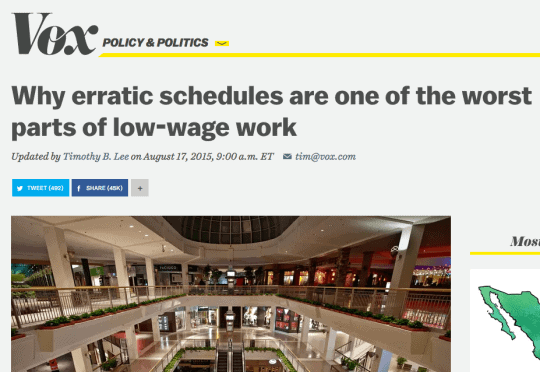Stories like this have been in the news before, but this was circulating the past few days: “Why erratic schedules are one of the worst parts of low-wage work.“
The story refers to so-called “just-in-time” scheduling techniques that jerk employees around and disrupt lives.
It happens to share a term, “JIT” with “Lean manufacturing” or just “Lean,” but it's either a coincidence or it's a bastardization of what Lean is really about. And I can prove it quite easily.

From Vox:
But Haley-Lock says it's not only large companies that have adopted software-based just-in-time scheduling techniques. Small businesses do it too.
For example, Haley-Lock visited a “little private ma-and-pa restaurant in a rural area of Washington state. The owner walked me through with great enthusiasm the Excel spreadsheet he used to track his labor-to-sales ratio. He'd track it on an hourly basis and would use it to send workers home.”
…
“You're waiting on your job to control your life,” Jannette Navarro, a Starbucks employee in San Diego, told the New York Times last year. She found out each week's schedule just three days ahead of time, and she said that Starbucks software often determined everything from how much sleep her son would get to “what groceries I'll be able to buy this month.” (Starbucks changed its scheduling policies after the Times article was published.)
Erratic shifts that vary from week to week make workers' schedules challenging enough. On-call shifts make things even worse. If the employer cancels a shift, the worker generally gets no pay — and might still be on the hook for child care expenses.
The use of on-call shifts, and variable schedules more generally, also creates a lot of uncertainty about workers' incomes from week to week. If business is slow for several weeks in a row, workers can wind up not making enough money to pay the rent. Espinal, the New York retail worker, says there were some parts of the year, such as after the holidays, when she could go days without getting a single shift.
The article makes a connection to Lean manufacturing:
The trend toward using computers to more tightly manage workers' schedules parallels the trend of just-in-time manufacturing. In the past couple of decades, manufacturers have used sophisticated software to slash inventories and order new parts at the last minute. This not only cuts down on warehousing costs, it also makes the whole production process more nimble, because manufacturers can switch to new and improved components as soon as they're available.
That's not really true in JIT and Lean production. It's L.A.M.E. or Lean As Misguidedly Explained.
Hear Mark read this article (subscribe to the podcast):
Lean Factories Don't Jerk People Around
When I was a consultant in auto supplier land, about 12 years ago, there was an auto supplier plant that made parts for Toyota, GM, and Chrysler.
Guess who had the more STABLE production schedules and orders to the supplier? Toyota did.
GM and Chrysler would jerk their schedules and orders around at the last minute, which was good for GM and Chrysler, but bad for the supplier in terms of the chaos it created.
Toyota wasn't trying to stick their inventory on the supplier. Arguably, Toyota was more respectful of the supplier and just being smart from a long-term business perspective (by not doing things that increased their suppliers' costs). There's a reason that Toyota (and Honda) rank highest in supplier relations.
“Just in time” scheduling shouldn't jerk around employees and it shouldn't jerk around suppliers.
Lean and the Toyota Production System are grounded in a foundation of “Respect for People.” What Vox describes seems pretty ruthless and more like GM and Chrysler of the early 2000s, not Lean.
Hospitals Often Jerk People Around, Not Toyota
The retailers that use their so-called “JIT scheduling” (it should be called “Jerk Around Time” scheduling) aren't doing so because a Lean book told them to do so. They're just combining a cost-cutting focus with computer technology.
Hospitals often try to manage their staffing to demand each hour during the day. Long before Lean entered the healthcare vocabulary, hospitals were using on-call shifts and sending people home early when it suited them. Hospitals call it “flexing” and I've been criticizing that practice on this blog since 2009 or earlier.
Toyota doesn't do this to their employees. If they aren't able to build cars or trucks, due to parts shortages or a line being down, they don't send employees home early to cut their pay and save money. Toyota continues to pay them, engaging them in training or continuous improvement (“Kaizen”) activities.
Toyota will also do this (pay employees for not building vehicles) for weeks or months at a time, given downturns in the industry sales or the problems that followed the big Japanese tsunami and earthquake. GM laid off employees, Toyota did not in the aftermath of the tsunami and a Japanese supplier being taken off line.
A Lean organization doesn't micromanage labor costs each hour to save a buck or two. A Lean organization engages everybody in partnering to reduce waste and improve the organization's performance, such as improving quality, safety, or customer satisfaction. Everybody wins.
So, it should be pretty clear that so-called “just in time” retail scheduling is the furthest thing from Lean.
Also see the book The Good Jobs Strategy for stories of retailers who do things the right way.
You can also comment over on LinkedIn for a broader audience, if you'd like.
What do you think? Please scroll down (or click) to post a comment. Or please share the post with your thoughts on LinkedIn – and follow me or connect with me there.
Did you like this post? Make sure you don't miss a post or podcast — Subscribe to get notified about posts via email daily or weekly.
Check out my latest book, The Mistakes That Make Us: Cultivating a Culture of Learning and Innovation:










Ahh. One of the dirty secrets in healthcare are organizations that misuse volume adjust staffing.
A couple of distinctions first.
Labor and benefit expenses are typically much higher in healthcare than in manufacturing so naturally get more attention. Whether it should or not considering other types of waste could be discussed.
Much has been done in manufacturing to level demand over the past several years. This makes staffing tremendously more easy than in services in healthcare that are unscheduled. I’ve seen parts manufacturers that ship to order but are reluctant to admit that their customer requires several weeks of inventory in a warehouse (remember the brake component fire at a Toyota supplier back in the 90’s and the more recent nuclear disaster in Japan?).
Manufacturing can take advantage of temps much more readily than in healthcare. While many organizations in healthcare use temps, it is highly undesirable for obvious reasons and they typically do it for chronic understaffing as compared with daily staffing demand adjustments.
Also, staff generally prefer to be called-off rather than take a lower salary. I can call you off up to 5% of the time and pay you $30/hr or I can pay you $29/hr and not call you off. In almost every case the employee will choose the $30/hr rate.
Many 24 x 7 healthcare organizations don’t provide weekend night standard shifts or adequate differentials. So nights and weekends are “punishment” and increase the variation in work schedules. Differential shift rates should go up and weekday day shift rates should go down until there is an equilibrium so that weekends and nights are staffed consistently without the perception of a penalty.
Lastly, training and skills of employees in hospitals aren’t set up to take advantage of an individual’s or a group’s free time. A labor and delivery nurse simply isn’t going to fill a critical care shift that needs to be filled let alone sweep the floor or do terminal cleaning in the OR. I am not saying that something like this shouldn’t be exploited, I am just saying from a practical matter in all but the very smallest hospitals it’s not likely to happen.
Enjoyed the topic.
Thanks for your comments, BS. Data shows that patients don’t get the same quality care or outcomes on the nights or weekends, speaking to your point about not providing the right 24×7 care.
You’re right that labor costs are high (50 to 70% of a healthcare organization’s cost)… but maybe that’s all the more reason to engage those people as valued partners and not just a cost? They have brains that can help reduce other significant costs.
Some of the discussion over on LinkedIn:
Trevor Waldo wrote:
I wrote:
There’s nothing wrong with what you describe, Trevor. I’ve seen emergency departments change their shift patterns beyond the simplistic 7 am to 7 pm or 7 pm to 7 am model. Some people come in at 7, some at 10, etc. throughout the day. But, everybody works a full shift and a consistently scheduled pattern that doesn’t jerk them around. Having people “float” to other tasks or areas is fine to me, IF they are properly cross trained and oriented… or “other projects” is probably a better use of their time, long-term, compared to sending them home.
The other principle from “The Good Jobs Strategy” book is that you need to schedule in SLACK time. You’d rather be slightly OVER-staffed, which sounds waste or counterintuitive to people, except it really helps with patient flow and the slack time can be used for improvement, training, or helpful indirect tasks.
Thanks again for raising this issue. I think hospitals can do much better on this topic. Ultimately hospitals should be using nurses and the like as knowledge workers instead of production workers. My spouse was a nurse and we used to laugh when after she was called off and she would ask if anyone in my administrative department was called off that day. No, people in administration are ALWAYS busy was my response.
Ironically, Toyota and companies like them treat their production workers more like knowledge workers… compared to the way many hospitals treat their nurses and other healthcare professionals.
Hospitals can do much better. Some do, thankfully.
You can see it in the Franciscan St. Francis videos:
https://www.leanblog.org/tag/franciscan-videos/
The NY attorney general is pressuring stores to stop “on call” scheduling as a violation of fair wage laws.
NY attorney general says retailer to end on-call scheduling
Bath & Body Works to End On-Call Scheduling
The New York attorney general is pressing some retailers on the practice of on-call scheduling:
http://www.ag.ny.gov/pdfs/Labor-Merge-final.pdf
[…] So-Called “Just in Time” Retail Staff Scheduling is not #Lean At All […]